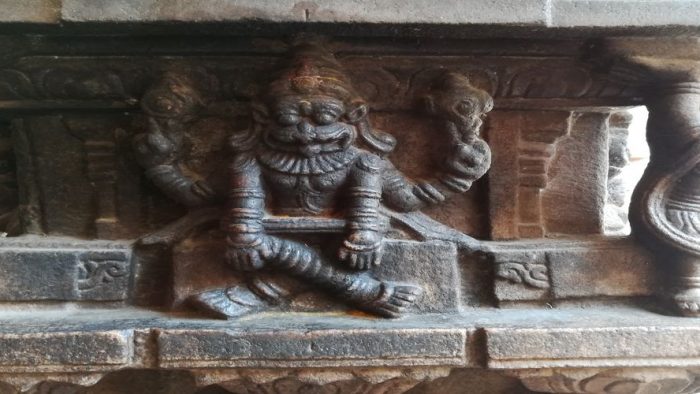Upasana is one of the central practices of almost all Hindu spiritual traditions, regardless of their philosophical or theistic orientations. Often translated as worship or meditation it comes from the Sanskrit root ‘up’ and ‘asana’ which means ‘to sit near’ or ‘to stay close by’.
The oft-used phrase ‘Devata Upasana’ would thus imply being near the Devata by continuously either fixing up the mind on the form of the Devata or directing the mind to meditate on the formless Brahman, who is the substratum of all manifestation and who Himself manifests as different Devatas.
As Swami Achalananda describes, ‘Upasana is the process of practising the proximity of God and of progressively feeling his presence till one merges in Him’ (1).
While Upasana in its primary sense refers to Dhyana or meditation, especially in the Upanishads- either on formless Brahman, or on various aspects of Brahman, or through metaphors indicating Brahman, or lastly on different Devatas that are manifestations of Brahman; in its expanded sense, it actually came to be associated with two interrelated but distinct concepts of Puja and Bhakti-yoga.
Let us now explore a bit more into all the three streams of Upasana as Dhyana, Puja, and Bhakti.
Upasana as Dhyana
The first and the primary stream of Upasana was its understanding as Dhyana or meditation. It is in this sense that the Upanshads understood the term Upasana. It is in this sense that Aranyakas have been classified as Upasana-Khanda- the portion of the Veda that describes various modes of meditation. Upasana retains this primary meaning as Dhyana even when it developed into inter-related but distinct streams of Puja and Bhakti. Dhyana finds a central place in Itihasa-Purana-Tantrika-Agamika traditions as well.
Dhyana means one-pointed concentration or meditation fixed upon the object of meditation. In the case of Upasana, the object of meditation is Brahman, often meditated using various symbols, metaphors, names, or forms. Vidya Upasana or Devata Upasana involves meditation on any particular aspect of Brahman either in an abstract way or in a more personalized way as the case may be. While Vidya literally means ‘to Know’, Devata means ‘the Shining one’. Thus, they are both related to knowledge. However, while Vidya Upasana seems to convey meditation on knowledge of Brahman in a more abstract sense, Devata Upasana conveys a meaning of meditation on knowledge in a more theistic sense.
The Upanishads prescribe many different forms of Upasana. Ishavasya Upanishad (2) provides a beautiful Upasana of Satya Brahman, the Purusha who inhabits the Surya Mandala, who is concealed by a golden vessel as it were, and who is non-different from the Purusha who inhabits the individual Jiva. Kena Upanishad (3) provides four meditations on Brahman, two in the divine context (Adhidaivika) and two in the context of the individual self (Adhyatmika). It says that one must meditate on Brahman as it is like the flash of the lightening or as fast as the blinking of the eye in the divine context. At Adhyatmika level, it says, one must meditate on Brahman as that towards which the mind seems to repeatedly go towards and repeatedly remembered; or it must be meditated with the help of the name ‘Tadvanam’- the most adorable one. Taittiriya Upanishad. Mandukya Upanishad provides meditation on the sacred Om.
In his book, ‘The Thirty-Two Vidya-s’, K Narayanaswami Aiyar (4) lists thirty-two different kinds of meditation described in various Upanishads, the more famous among them include: Madhu Vidya, Pranavidya, Bhuma Vidya, Shandilya Vidya, Vaishvanara Vidya and Dahara Vidya from the Chhandogyopanishad, Panchagni Vidya is mentioned in both the Chhandogyopanishad and the Brihadaranyakopanishad, Anandamaya Vidya from Taittiriya Upanishad, Akshara Vidya, Jyotisham Jyotir-Vidya and Maitreyi Vidya from Brihadaranyakopanishad, Nachiketagni Vidya and Angushtamatra Vidya from Katha Upanishad, to name a few.
Among these, Shandilya Vidya, Panchagni Vidya, Bhuma Vidya, Dahara Vidya, Maitreyi Vidya, and Vaishvanara Vidya are perhaps among the more famous forms of Upanishadic meditations.
Shandilya Vidya is a meditation taught by Rishi Shandilya. He instructs the practitioner to meditate upon Self as being Manomaya with Prana as its body and effulgence as its form; being smaller than an atom and bigger than the universe, containing all works, desires, odours, tastes, etc. which is situated within the heart.
Panchagni Vidya is the meditation of five fires wherein five acts of the universe are conceived of as five symbolic sacrificial fires with its five components of fuel, smoke, flame, coals and sparks. The five symbolic fires which act as the object of meditation are the Svarloka (heaven), Bhuvar Loka (intermediate space), and Bhuloka (earth), man and woman.
A table representing the five-fire meditation as enunciated in the Brihadaranyaka Upanishad is given below.
| Fire | Fuel | Smoke | Flame | Cinder | Spark | Oblation | Fruit of the Sacrifice | |
| 1 | Svarloka/ Heaven | Aditya/ Sun | Light-rays | Day | Four-Quarters | Intermediate Quarters | Shraddha/ Faith | Soma |
| 2 | Parjanya/ the Deity of Rain | Year | Clouds | Lightning | Thunder | Rumblings | Soma | Rain |
| 3 | Bhuloka | Earth | Fire | Night | Moon | Stars | Rain | Food |
| 4 | Man | Open Mouth | Prana | Speech | Eyes | Ear | Food | Semen |
| 5 | Woman | Phallus | Pubic Hair | Yoni/ Vulva | Sexual Intercourse | Sexual delight (orgasm) | Semen | Offspring |
Bhuma Vidya is the instruction for meditation given by Rishi Sanatkumar to Rishi Narada. It involves meditating upon Brahman as Bhuma or infinite, where one cannot see another, where one cannot hear another or intuit another. Contrary to this, where one can see, hear, or intuit another, it is called Alpa or finite. And That which is Infinite is Immortal, and that which is finite is mortal. Thus, one must meditate upon Bhuma as one infinite whole without a second.
Dahara Vidya is a type of meditation wherein one meditates upon his Heart, the innermost Self. Swami Sivananda (5) says: “This is one of the greatest of the Vidyas. The all-pervading and all-inclusive nature of the Self is stressed upon in this Vidya. In this meditation, the meditator feels the whole universe as his Self and excludes nothing from the One Self. This Vidya further explains the identity of the external and the internal, the objective and the subjective, the macrocosmic and the microcosmic, the universal and the individual, Brahman and Atman.”
Maitreyi Vidya refers to the teaching of meditation taught by Rishi Yajnavalkya to his wife Maitreyi. It involves meditating on the Atma or innermost Self as the true object of one’s love.
Vaishvanara Vidya involves meditating upon Brahman as Vaishvanara Atma whose head is the heaven, his eyes Surya, his breath Vayu, his trunk Akasa, his bladder the Rayi, his feet the earth, his chest the sacrificial altar, his hairs the sacrificial grass, his heart the Garhapatya fire, its mind the Anvaharyapachana fire (Dakshinagni), his mouth the Ahavaniya fire. Here while the Vaishvanara is understood as pervading the three words, he is described as constituting the three fires from the standpoint of Agni and Upasana is also conducted from this standpoint of Agni Vaishvanara only (6).
This wealth of Upasana techniques enunciated in the Upanishads were later further developed in different Hindu traditions. Patanjali Yogasutras, for example, provides an eight-limbed framework for spiritual emancipation, wherein Dhyana plays a central role. Similarly, Tantric traditions explored different forms of meditation with texts like Vigyana Bhairava Tantra belonging to Trika School of Kashmir Shaivism enunciating 112 techniques of meditation. The Itihasa-Purana tradition also provided many different techniques of meditation, especially those related to different Devatas, which later developed into a full-fledged procedure of worship.
These Upasana methods were enunciated in the Upanishads primarily for spiritual practitioners who did not have the competency to pursue Vedanta Sadhana. The primary aim was to help them develop one-pointed concentration and purification of the mind. Later traditions, further built upon this and provided elaborate mechanisms to accomplish the twin goals.
Upasana as Puja
The second stream of Upasana, which especially developed in the Pauranika, Agamika, and Tantrika traditions was the understanding of Upasana as Puja or ritual worship.
Puja literally means worship, invocation, or showing reverence. Kularnava Tantra (7) defines Puja as a spiritual action that quells the Karmic burden flowing from previous lives, thereby putting an end to the cycle of birth and death leading to complete fulfilment. Mahanirvana Tantra (8) notes that Puja is the oneness of the Jiva and Atma.
Puja has a wider connotation of worship which includes not only internal elements of concentration and meditation, but also elements of external worship like purification (Shuddhi), Divinization (Nyasa), the invocation of the deity (Avahana), and various external offerings to a deity (Upachara) (9). Devi Bhagavatham (10), in fact, classifies worship into external and internal and further classifies external worship into Vedic and Tantrik. Mahanirvana Tantra (11) comments that the highest form of worship is abiding in the state of Brahman-consciousness; next comes abiding in the state of meditation; practising Japa and chanting of mantras are lower forms of worship, and lowest form of worship is external worship.
Here, the gradation is not used to depreciate the importance of external worship, but only to show how external rituals have been designed to slowly lead the individual to the highest state of meditation and inner steadfastness and ultimately lead to the highest goal of worship: being one with Brahman.
On the relationship between Vedic and Tantrik forms of external worship, Dr. Mahanamabrata Brahmachari (12) notes: “From ancient times, the Vedic philosophic truths and the Tantric rites like worship, etc. have been conjoined and have thus been fulfilling each other –each compensating for the other’s limitations… On certain auspicious occasions, the performance of both the (Vedic) Yajna as well as (Tantrik) Puja becomes essential. Yajna is a special contribution of the Vedas; Puja, of the Tantras. Vedas and Tantras are complementary to each other.”
Thus, the Vedic Yajna and the Tantrik Puja are complementary external forms of Upasana designed to lead a worshipper to higher meditative stages of Upasana.
The standard procedure of Puja involves 16 offerings to the deity called “Shodasha Upachara’. The Puja usually begins with Shuddhi (purification), followed by Pranayama (regulation of breath), and Sankalpa (intention). Then, commences the 16-staged process that involves: Dhyana (meditation on the form of the deity), Avahana (invocation of the deity in Vigraha, Yantra, or Agni), Asana (offering the seat), Padya (washing the deity’s feet with clean water), Arghya (offering water to rinse hands and mouth), Achamana (Offering water to drink), Snana (bathing the deity), Vastra (offering new clothes), Yajyopaveeta (offering the sacred thread), Gandha (applying sandalwood paste), Pushpa (offering fresh flowers), Dhoop (Incense is burned before the deity), Deepa (waving a lamp before the deity), Naivedya (offering food and fruits to the deity), Tambula (Offering the deity a refreshing mix of betel nut and leaves), and finally Pradakshina & Namaskara (offering prayers by doing circumambulation followed by salutation and bidding farewell to the deity).
A shorter version involves offering only 5 Upacharas called Pancha-Upachara Puja, while there is an elaborate Puja procedure which involves 64 offerings called Chatushasti Upachara puja. In certain Tantrik traditions, Panchamakara or the Five M’s are offered to the deities: madya (alcohol), maṃsa (meat), matsya (fish), mudra (gesture), maithuna (sex). In the Agamika tradition, this notion of invocation and worship of the deity as well as the ritual structure of Vedic Yajna transformed into the concept of temple and temple worship.
A good example of how the external ritual elements are designed to bring about internal transformation and eventually lead one to higher meditation can be understood from Mahanirvana Tantra (13) that provides an internal counterpart of each of the external Upacharas. It says one should offer the heart-lotus as the seat of the deity; the nectar that emanates from the Sahasrara in the head must be utilized for Padya, Arghya, Achamana and Snana; the Akasha Tattva as the Vastra; the Gandha-Tattva as the sandal-paste; the Chitta or mind as the flowers; Prana or the vital energy as the Dhoopa; the Tejas-Tattva as the Deepa; and the ocean of nectar as the Naivadya. It further says that one should offer the ten flowers of – lack of ignorance, lack of pride, detachment, non-bragging, absence of delusion, absence of arrogance, lack of hatred, unagitated composure, lack of envy, and absence of greed. It suggests offering five more flowers of Ahimsa, sense-control, compassion, forbearance and knowledge.
In other words, the external Puja Upacharas and ritual procedures are intended to create inner transformation leading one to the development of virtues mentioned above, which in turn will make one capable of performing inner Puja or meditative stages of Upasana,, ultimately leading one to Chitta-Shuddhi and Ekagra-Chitta (purification of the mind and one-pointed concentration, respectively) needed for entering Vedanta or Jnana-Sadhana.
Upasana as Bhakti-yoga
The third stream of Upasana, which has its roots in the Upanishads, but developed its distinct flavour in the Itihasa-Purana tradition, especially Mahabharata and Bhagavata Purana, and was later further developed by different devotional traditions was the understanding of Upasana as Bhakti-yoga.
Different definitions of Bhakti are available in Hindu tradition.
Narada Bhakti Sutra (14) gives the following definition of Bhakti: It is of the nature of Supreme Love for Ishwara; and is of the nature of Amruta or immortal Bliss. A similar definition is found in Shandilya Bhakti Sutra (15), another authoritative text on Bhakti which says: It is the supreme unshakable attachment to Ishwara. From the above definitions, we can discern two elements in understanding Bhakti: that it is of the nature of Supreme Bliss, and that it is Supreme Love directed towards Ishwara.
Enunciating on the second element, Adi Shankaracharya in Shivaanandalahari (16), defines Bhakti as: “When the modification or thought-patterns of the mind reaches the lotus feet of Pasupathi and becomes seated there permanently, then that condition is called Bhakti.” Madhusudhana Saraswati provides an even more elaborate definition in Bhagavad-Bhakti Rasayana (17) where he says: “The Manaso Vritti or the modification of the mind melted by the (practice of) Bhagavad-dharma that has become a continuous, stream-like flow directed toward Sarvesha or the lord of all is called Bhakti.”
In short, at the highest level, Bhakti is the constant abidance in the Supreme bliss of Ishwara by a person with the melted mind. It is a practice of meditation by those with melted mind wherein the object of meditation is Ishwara or one of his manifestations as Devatas with whom a personalized relationship of love is cultivated and the goal is a complete merger with Ishwara. Bhakti is thus a spontaneous extension, a logical conclusion of the Upanishadic Saguna Upasana. However, this practice of Bhakti or Bhakti-yoga is different from both Yogic Dhyana and Vedantic Niddhidhyasa in one significant way. While Bhakti yoga can be practised only by the melted mind, melting of the mind is not required for the practice of the other two.
Madhusudhana Saraswati (18) says that in such a mind melted by devotion as described above, Ishwara himself enters and becomes established permanently just as a colour added to the melted wax becomes forever established in the wax!
However, that is only the description of Bhakti at the highest level. To reach there, a practitioner has to first go through different stages of devotion and practice lower forms of devotion. In Bhagavad Purana (19), Prahlada, the famous devotee of Lord Narasimha enunciates the nine-kinds of devotional practices thus: “Hearing, chanting, remembering, serving the feet, offering ritual worship, offering prayers, serving as a servant, becoming the best friend and surrendering one’s own self to Vishnu.”
The last practice called as the ‘Atma-Nivedanam’ or the surrendering of one’s Self completely with Ishwara implies complete merger with Ishwara, the highest goal of Bhakti. Regarding this, Madhusudhana Saraswati says in his commentary to Bhagavad Gita called Gudhartha Dipika (20) thus: “With the maturity of spiritual practice, three types of surrender to God come about- ‘I belong to him indeed’, ‘He belongs to me indeed’ and ‘I am He indeed’.” These are the three stages of Bhakti through which a devotee invariably goes through as his Bhakti matures more and more. But to reach the mature stage one must first practice various devotional practices like hearing, singing etc. that help in developing one-pointed concentration and meditation on Ishwara.
Thus, Upasana as Bhakti-yoga is a special kind of meditation practice rooted in devotion and Saguna worship. It intends to purify the mind of the practitioner and help him develop one-pointed concentration through devotion and development of personal connection with Ishwara who responds to the devotee by becoming his Ishta-Devata or favourite deity. Here the path starts with singing bhajans, chanting mantras, listening to stories of Puranas, and slowly leads to higher meditative stages of Upasana, ultimately culminating with the manifestation of Ishwara in one’s own Hrdaya and eventual merging of Jiva with Ishwara.
Conclusion
To conclude, though in its primary sense Upasana refers to Dhyana or meditation, over the centuries, it has not only flourished through different Dhyana-based spiritual traditions but has also developed comprehensively through two other inter-related but distinct streams: Puja and Bhakti-yoga.
Through these three streams, Devata Upasana takes a spiritual practitioner to higher practices of meditation by facilitating Ekagra-Chitta or one-pointed concentration and Chitta-Shuddhi or purification of the mind, and eventually lead him/her to attain either Jivanmukti or Krama-Mukti.
[This article forms a chapter in the upcoming book of the author on Ishavasya Upanishad]
References:
1. Swami Achalananda, Introduction, ‘Meaning and Significance of Worship’, Page 8, Sri Ramakrishna Ashrama, Mysuru.
2. Ishavasya Upanishad Verse 15-16
3. Kena Upanishad 4.4-6
4. K Narayanaswami Aiyar, ‘The Thirty-Two Vidya-s’, The Adyar Library Series.
5. Swami Sivananda, ‘Vidyas from the Upanishads’, The Divine Life Society. [http://sivanandaonline.org/public_html/?cmd=displaysection§ion_id=759]
6. K Narayanaswami Aiyar, ‘The Thirty-Two Vidya-s’, Page 68, The Adyar Library Series.
7. Kularnava Tantra 17.70
8. Mahanirvana Tantra 14.123
9. Swami Muktidananda, A Word with the Worshipper, ‘Meaning and Significance of Worship’, Page 12, Sri Ramakrishna Ashrama, Mysuru.
10. Devi Bhagavatham 7.39.3
11. Mahanirvana Tantra 14.122
12. Dr. Mahanamabrata Brahmachari, Candi Cinta (Bengali), Page 9; Cited from ‘Meaning and Significance of Worship’, Page 155, Sri Ramakrishna Ashrama, Mysuru
13. Mahanirvana Tantra 5.143-149.
14. Narada Bhakti Sutra, Verse 2-3
15. Shandilya Bhakti Sutra Verse 2
16. Shivaanandalahari Verse 61
17. Bhagavad-Bhakti-Rasayana Verse 3
18. Bhagavad-Bhakti-Rasayana Verses 8-10
19. Bhagavada Purana Verse 7.5.23
20. Gudhartha Dipika on Bhagavad Gita Verse 18.66
Disclaimer: The opinions expressed in this article belong to the author. Indic Today is neither responsible nor liable for the accuracy, completeness, suitability, or validity of any information in the article.










